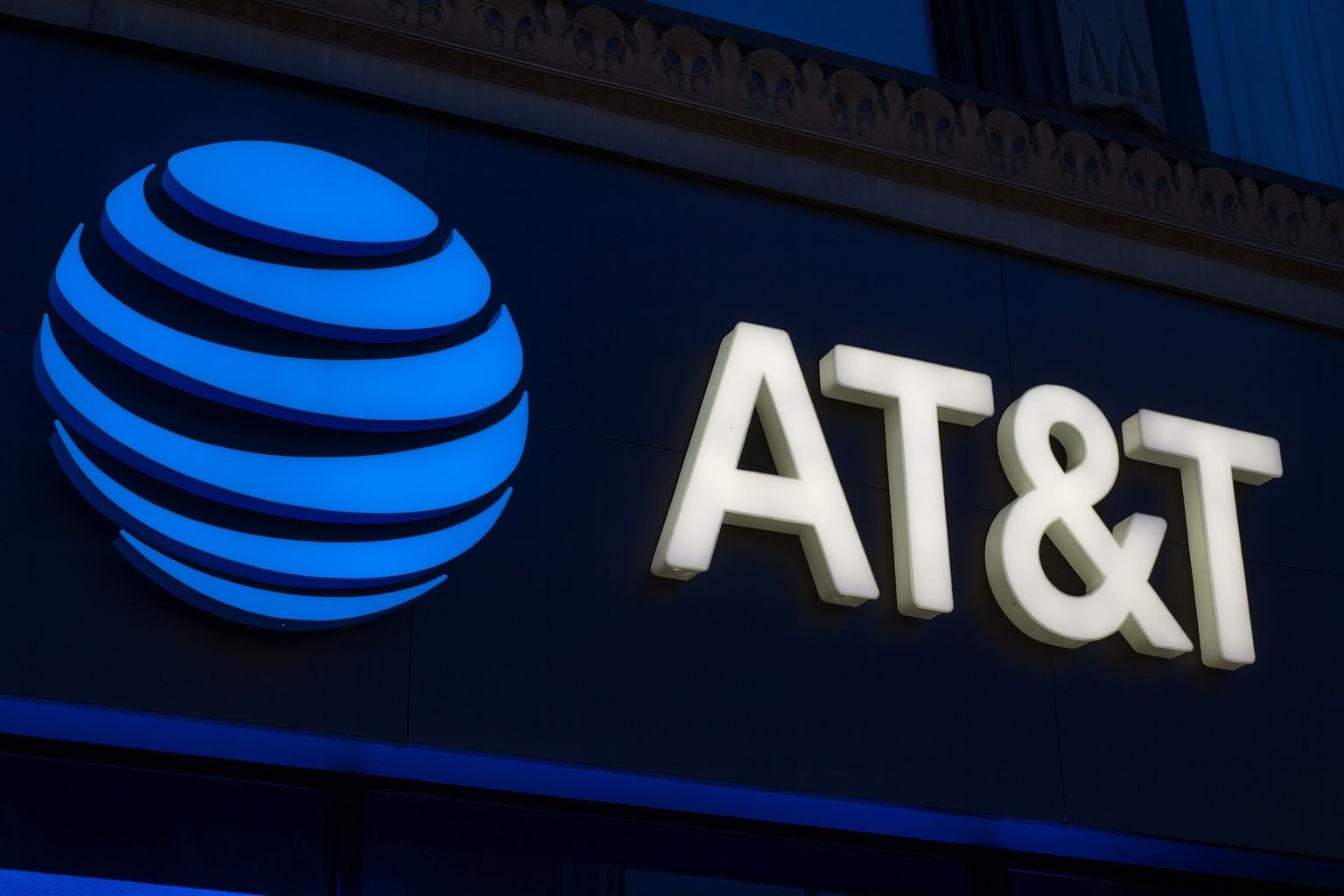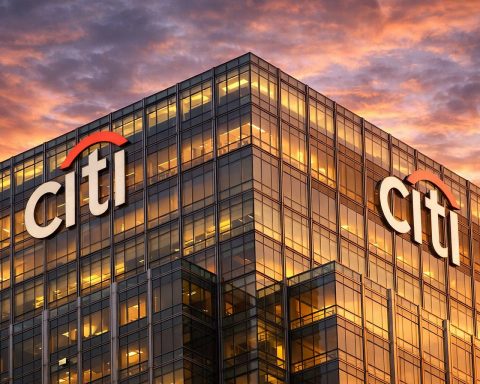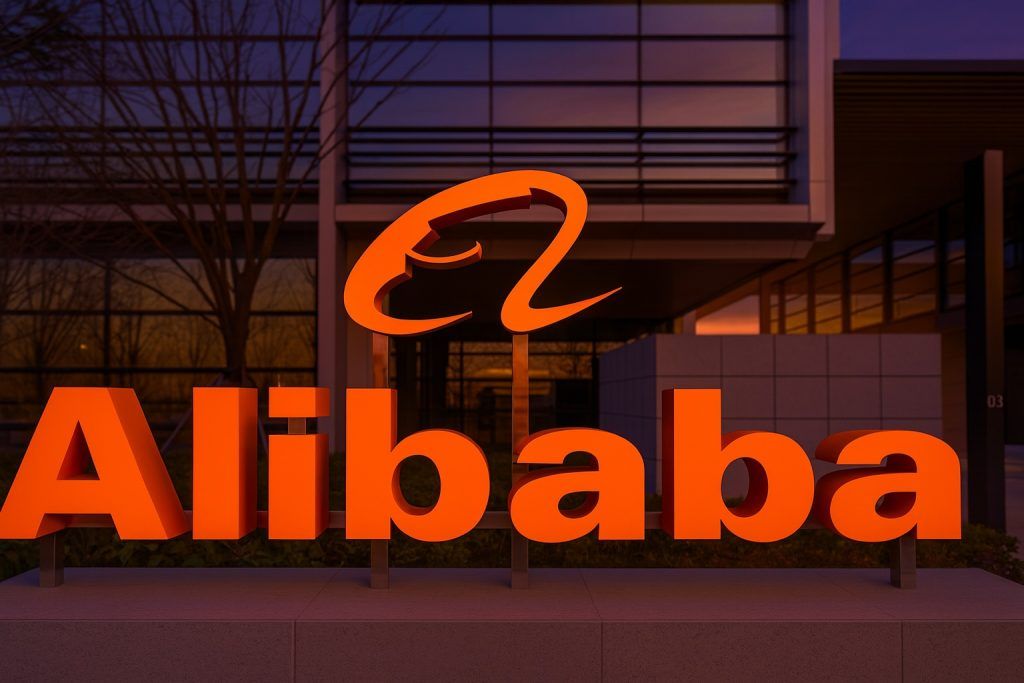Key Facts (as of Oct. 20, 2025):
- Share Price & Recent Performance: AT&T (NYSE:T) stock trades around the mid-$26 range, closing last week at $26.34 [1]. Shares have been relatively flat in recent days, inching up from mid-week lows (~$26.07) [2]. The stock is up roughly 20% year-over-year, though it lagged the broader market in the past month [3]. AT&T’s 12-month range spans $21.05 to $29.79 [4].
- Upcoming Earnings Catalyst: AT&T will report Q3 2025 earnings on Oct. 22. Wall Street expects earnings of about $0.54–$0.55 per share on $30.9 billion in revenue [5], a modest 2–3% sales rise but ~8–10% lower EPS year-on-year. Some analysts predict a beat on EPS, noting AT&T has the ingredients for an upside surprise [6]. The telecom reaffirmed its full-year outlook (adjusted EPS ~$2.00; free cash flow ~$16 billion) [7] [8], sustaining investor focus on whether it can hit those targets.
- Major Developments: AT&T has doubled down on its core connectivity business in 2025. In August, it announced a $23 billion purchase of wireless spectrum licenses from EchoStar [9] – a massive 50 MHz nationwide chunk of mid-band and low-band airwaves to bolster its 5G network. In May, AT&T agreed to buy Lumen Technologies’ consumer fiber internet business for $5.75 billion [10], adding ~1 million fiber customers and expanding its fiber footprint into cities like Denver, Phoenix, and Seattle [11]. Concurrently, AT&T has extended open-access fiber partnerships (e.g. with PRIME FiBER) to accelerate broadband rollout in new regions without bearing all the capital costs [12] [13]. These moves aim to cement AT&T’s lead in converged wireless + fiber connectivity.
- Business Focus & Financial Moves: The company is streamlining to focus on 5G and fiber growth. It sold its remaining DirecTV stake in July [14], fully exiting the legacy pay-TV business. Management also reiterated 2025 guidance and unveiled plans for $20 billion in share buybacks through 2027 [15] – signaling confidence in cash flows. AT&T expects to pass 60+ million locations with fiber by 2030 (including acquisitions/partnerships), roughly doubling current coverage [16]. Meanwhile, it continues to carry a hefty debt load (~3× net debt/EBITDA post-spectrum deal) but vows to deleverage to ~2.5× within 3 years [17] [18], aided by $6.5–8 billion in anticipated tax savings over 2025–27 [19].
- Market Sentiment & Analyst Views: Wall Street’s outlook on “T” is mixed. Goldman Sachs reiterated a Buy rating (target $32) after the spectrum purchase, calling it a smart long-term move to fortify AT&T’s mobile and fixed wireless position [20]. “Even though the license came at a high price, it strengthens the company’s position in the mobile market,” noted Goldman’s analyst, who also applauded AT&T’s focus on share buybacks and subscriber growth [21] [22]. Barclays, however, downgraded AT&T to Equal Weight (Hold) on valuation concerns, arguing the stock’s recent rebound already “largely reflects [AT&T’s] operational gains” and noting intense competition and high debt levels [23]. Barclays set a $30 target (~9% upside) [24] [25]. Overall, AT&T carries a consensus “Moderate Buy” rating with price targets averaging around $30–31 [26]. Investors remain drawn to AT&T’s hefty dividend (yielding ~4% at current prices) and relative value – the stock trades at ~13.8× forward earnings, a discount to the telecom industry’s ~21× average [27] – but there’s caution about its low growth and ongoing price wars in wireless.
AT&T Stock Price & Recent Performance
AT&T’s stock has been stuck in neutral in October, even as broader indexes climb to new highs. Shares closed Friday (Oct. 17) at $26.34 [28], up slightly from earlier in the week (~$26.07 on Wednesday) but still in the mid-$20s range. This leaves the telecom giant roughly flat month-to-date. By contrast, the S&P 500 and Dow are hovering near record levels after a strong week [29]. Year-to-date, AT&T has not enjoyed a tech-style rally – its stock is up about 15–20% in 2025, trailing the tech-heavy Nasdaq’s ~15% gain just year-to-date by mid-October [30] [31].
However, zooming out shows notable progress: AT&T is up roughly 20% from one year ago [32], outperforming rival Verizon over the same period. In fact, AT&T hit a 12-month high near $29.79 this summer [33], before pulling back. (Its 12-month low was about $21.05 [34], reached in late 2024 amid broader telecom doldrums.) The stock’s rebound has been fueled by improving financial results and investor optimism in AT&T’s turnaround strategy. But recent underperformance suggests caution ahead of earnings – traders are in “wait-and-see” mode, digesting both company-specific developments and sector headwinds.
Notably, AT&T’s beta is low (~0.4) [35], meaning the stock tends to move less than the market – fitting for a defensive telecom name. The share price has also been anchored by its dividend appeal. At ~$26 per share, AT&T’s annual dividend (currently $1.11) yields roughly 4.2%, making it attractive to income investors even after a 2022 payout cut. That yield, while solid, is lower than Verizon’s ~7% yield – reflecting AT&T’s recent price recovery and dividend reset. With the Federal Reserve now widely expected to cut interest rates later this month [36] [37], high-dividend stocks like AT&T could see renewed interest if bond yields fall, although any Fed move also signals concerns about economic slowing. In short, AT&T’s stock has been range-bound lately, and the upcoming earnings report may be the catalyst needed to break it out – for better or worse.
Big Bets on 5G Spectrum and Fiber – AT&T’s Strategic Moves
Under CEO John Stankey, AT&T has spent 2025 making bold investments in its core telecom infrastructure – effectively betting that heavy upfront spending now will pay off in future growth and market dominance. The most headline-grabbing move came in late August, when AT&T agreed to acquire a vast trove of wireless spectrum from EchoStar for $23 billion [38]. This deal hands AT&T about 30 MHz of mid-band (3.45 GHz) and 20 MHz of low-band (600 MHz) spectrum nationwide [39] – averaging 50 MHz added across virtually every U.S. market [40]. For context, mid-band spectrum is gold for 5G: it offers a mix of range and capacity, crucial for faster mobile data and for fixed wireless broadband (home internet via cellular).
Stankey championed the spectrum buy as a long-term boon. “This acquisition bolsters and expands our spectrum portfolio while enhancing customers’ 5G wireless and home internet experience in even more markets,” the AT&T chief said [41]. No one brings wireless and fiber internet to more places or does it better than AT&T, he added confidently [42]. The new airwaves will let AT&T beef up 5G coverage and speeds – “adding fuel to our winning strategy of investing in valuable wireless and broadband assets to become America’s best connectivity provider,” as Stankey put it [43].
That said, AT&T paid top dollar for these licenses. Industry analysts noted the $23 billion price tag is roughly $7 billion higher than what the spectrum fetched at auction [44]. Stankey candidly admitted the price was high, calling it “more than what Dish paid for spectrum at auction” – but he framed it as the cost of doing business to secure strategic assets [45] [46]. “There are speculators who buy spectrum and later sell it for more… that’s the nature of auctions and what occurs,” he explained, essentially saying AT&T knew it was paying a premium but deemed it worthwhile for the long run [47]. The deal, expected to close in 2026 pending regulators [48], will nudge AT&T’s leverage higher (net debt/EBITDA to ~3× [49]). Yet AT&T insists it can manage the debt – pointing to $8 billion in anticipated tax benefits (from new legislation) over the next three years [50] [51] and pledging to return to a ~2.5× leverage ratio by 2028 [52]. In fact, AT&T reiterates that it won’t sacrifice shareholder returns: the company maintained its 2025 financial guidance and capital return plans alongside the spectrum news, including an expected $20 billion share repurchase capacity for 2025–2027 [53] [54].
On the fiber broadband side, AT&T is executing an equally aggressive expansion. The telecom giant has identified fiber-to-the-home as a key growth engine (for high-speed internet and future-proof network quality) and is racing to widen its fiber footprint across America. A landmark move came in May 2025, when AT&T announced a deal to acquire Lumen Technologies’ Mass Markets fiber business for $5.75 billion in cash [55]. This acquisition will bring AT&T 1 million new fiber subscribers and thousands of miles of fiber network in multiple metro areas. According to the company, it significantly expands AT&T’s fiber operations in cities including Denver, Las Vegas, Minneapolis, Orlando, Phoenix, Portland, Salt Lake City and Seattle [56] – many of which were outside AT&T’s traditional footprint. Essentially, AT&T is picking up Lumen’s entire consumer ISP business (branded “Quantum Fiber”), which had built out fiber in those markets. Once the deal closes (expected in H1 2026), AT&T will fold these assets into a new subsidiary and may sell a minority stake in that unit to a financial partner [57] [58] – a strategy AT&T has used before (e.g. its Gigapower joint venture with BlackRock, which similarly funds fiber builds).
The Lumen fiber buy aligns with AT&T’s strategy of scale and convergence: more fiber in the ground means more homes and businesses it can sell gigabit internet to, and bundling those customers with AT&T wireless service (the coveted “one-stop connectivity” bundle). “We are winning in a highly competitive marketplace, with the nation’s largest wireless and fiber networks,” Stankey said after Q2, highlighting milestones like 30 million+ fiber locations passed and over 1 million AT&T Internet Air (fixed wireless) customers as evidence the strategy is working [59]. AT&T’s plan is to reach 50 million fiber locations by 2030 organically, and 60 million+ including acquisitions and partnerships [60] [61]. The Lumen deal alone boosts those figures considerably. It also underscores AT&T’s focus on its “converged connectivity” approach – using whatever mix of fiber and 5G wireless necessary to serve every corner (and phasing out old copper lines in the process).
Beyond acquisitions, AT&T is leveraging partnerships to extend fiber. It has embraced an open-access fiber model, teaming with third-party fiber builders that deploy infrastructure which AT&T can then use to offer service. For example, AT&T partnered with PRIME FiBER, a wholesale fiber provider, initially in Florida and now in Arizona’s Sun City and Peoria areas [62] [63]. Under this model, PRIME FiBER lays down fiber-optic cables in underserved communities, and AT&T leases that capacity to sell AT&T Fiber internet [64] [65]. This lets AT&T expand faster and at lower upfront cost, essentially “renting” fiber rather than owning every strand. “We continue to leverage strategic partnerships with third-party infrastructure providers to accelerate deployment without bearing the full burden of capital-intensive builds,” AT&T’s SVP of broadband products, Erin Scarborough, noted, as AT&T pushes toward 30 million locations passed by end of 2025 [66] [67]. This collaborative approach helped AT&T add a record 243,000 fiber net adds in Q2 alone [68] (plus another 200k+ fixed wireless net adds), fueling nearly 19% YoY growth in consumer fiber revenue [69] [70]. The fiber momentum has translated into strong Consumer Wireline earnings (segment EBITDA jumped +18.6% YoY in Q1 [71]). These indicators bolster AT&T’s case that heavy investment in fiber will yield profitable growth and sticky, high-ARPU customers.
In shedding non-core assets, AT&T also completed its exit from the pay-TV business – a long-awaited strategic cleanup. On July 2, AT&T sold its remaining 70% stake in DirecTV to partner TPG Capital [72], effectively bowing out of satellite TV entirely. (AT&T had spun off DirecTV into a separate venture in 2021, retaining a stake, but now it’s fully off the books.) This move removes a declining legacy asset and allows AT&T to devote all attention to telecom services. Along with previous divestitures (WarnerMedia spinoff in 2022, Vrio Latin America, etc.), AT&T is now a focused communications company – wireless, broadband, and telecom services, full stop.
The sum of these moves is a transformative push to modernize AT&T’s network and refocus on connectivity. The company is investing tens of billions – in spectrum, fiber buildouts, and strategic deals – to position itself for the next decade of 5G and fiber demand. These bets reflect confidence: management reiterated its 3%+ annual EBITDA growth goal through 2027 [73] and even projected double-digit EPS growth by 2027 [74] as the payoff from current investments kicks in. For investors, the key question is whether AT&T can execute on these initiatives without straining its balance sheet or sacrificing returns in the interim.
Earnings on Deck: Q3 Results and What to Watch
All eyes are now on AT&T’s third-quarter 2025 earnings, due Wednesday, Oct. 22. This report will shed light on how well AT&T’s strategy is translating into financial performance – and could sway the stock’s trajectory for the rest of the year.
Analysts expect solid, if unspectacular, numbers. The consensus forecast pegs Q3 revenue around $30.96 billion, up ~2.5% year-over-year [75], and adjusted earnings per share (EPS) around $0.54–$0.55 [76]. That EPS would mark a decline from the $0.60 AT&T earned in Q3 2024, reflecting higher interest expense and hefty promotional costs. (Notably, AT&T and its rivals have been doling out generous phone subsidies – “free” 5G iPhones with multi-year contracts – to win and keep subscribers. Those deals boost customer adds but pressure short-term margins, a dynamic investors are tracking closely [77] [78].)
Despite the lower year-over-year profit forecast, some see a chance for an earnings beat. Zacks Investment Research recently highlighted that AT&T “possesses the right combination of the two key ingredients for a likely earnings beat” this quarter, citing its earnings ESP (Expected Surprise Prediction) and Zacks Rank [79]. In fact, AT&T surprised to the upside in Q2, posting $0.54 adjusted EPS vs. $0.53 expected [80] and continuing its streak of meeting or beating estimates in recent quarters. Schaeffer’s Investment Research also noted options market positioning that hints traders anticipate a post-earnings move [81]. Still, not everyone is convinced – another analysis predicted AT&T could miss EPS by a few percentage points if certain cost headwinds hit [82].
Key themes to watch in the earnings release and call include:
- Subscriber Growth: AT&T’s wireless postpaid phone net adds and fiber broadband net adds will be scrutinized. In Q2, AT&T added a healthy 401,000 postpaid phone subscribers (on par with Verizon, though T-Mobile typically leads) and 243,000 fiber internet customers [83]. Similar numbers in Q3 would underscore sustained momentum. Conversely, any slowdown – perhaps from Verizon’s renewed competitive push or saturation in some markets – could raise a red flag. Also, churn rates (customer turnover) will indicate how well AT&T is retaining users amid competition.
- Financial Metrics & Cash Flow: AT&T’s free cash flow (FCF) is critical given its dividend and buyback plans. The company generated $4.4 billion FCF in Q2 [84], and it needs roughly $4 billion+ per quarter in the second half to hit its $16+ billion full-year FCF goal [85]. Investors will want to see that cash flow is on track (Q3 is usually a strong quarter seasonally for cash). Additionally, look at EBITDA margins – are the heavy promotional expenses or any residual costs (like network build-outs) denting profitability more than expected? AT&T guided for ~3% adjusted EBITDA growth in 2025 [86]; any deviation could prompt forecast revisions. Also of interest: progress on cost reductions (AT&T has been executing billions in cost cuts over recent years to streamline operations).
- Guidance or Early 2026 Outlook: While AT&T likely won’t give official 2026 guidance yet, analysts will listen for commentary on next year’s trends. Topics could include the trajectory of wireless service revenue growth (AT&T hit ~3% YoY recently [87]), whether fiber growth can accelerate with the new assets coming online, and any changes in capital spending plans. AT&T has kept 2025 capex guidance at ~$22.5 billion [88], down from 2022–23 peaks, but with spectrum and fiber deals, will 2026 see an uptick or can they stay disciplined? Furthermore, any hints on the dividend (which has been held flat at $0.2775/quarter) or buyback timing (they’d done $1.3B of the $4B 2025 buybacks by mid-year [89]) would interest shareholders.
- Competitive Landscape Commentary: We’ll likely hear AT&T’s take on competition. Verizon, under a new CEO as of late 2025, has been aggressively matching AT&T’s bundle offers and even planning a $20B network deal (similar in scale to AT&T’s) [90] [91]. T-Mobile continues to tout ultra-fast 5G coverage and just brought in a new CEO as well [92], keeping pressure on the “big two.” Additionally, cable companies (Comcast, Charter) are growing their mobile subscriber base through MVNO deals, nibbling at the wireless market. AT&T might point to its relatively low churn (just 0.87% postpaid phone churn last quarter [93]) as evidence that its customers are sticking despite competitors’ promotions. Any color around pricing strategies, 5G home internet trends, or the impact of iPhone 15 promotions could be gleaned from management’s remarks.
- Network and Infrastructure Updates: Given AT&T’s numerous projects, investors will want updates on the EchoStar spectrum integration – even though it won’t officially be in AT&T’s hands until 2026, the company said it will begin deploying compatible 3.45 GHz gear ASAP to be ready [94]. Also, progress on the Lumen fiber acquisition (regulatory approvals, integration planning) and the expansion via Gigapower JV and PRIME FiBER deals may be discussed. Any mention of lead-sheathed cables (the legacy wiring issue that spooked telecom stocks in 2023) is unlikely if tests showed limited impact, but it’s a lurking background topic in telecom – AT&T previously indicated no material risk, so silence would imply status quo.
Overall, steady execution in Q3 – hitting subscriber and financial targets – could reassure the market that AT&T’s heavy investments are yielding results. The stock’s underperformance in recent weeks suggests expectations are muted, so there’s room for upside surprise. Conversely, a miss or cautious commentary (say, if consumer spending on telecom is softening or if AT&T hints it might moderate buybacks due to debt) could reinforce the skeptics’ case.
Wall Street’s Take: Optimism vs. Overhangs
Analysts and investors appear split on AT&T’s near-term prospects. On one hand, bulls argue that the company’s massive network investments and refocused strategy will drive a sustainable turnaround. They point to improvements like better-than-expected earnings in recent quarters, solid subscriber gains, and the company’s commitment to shareholder returns (buybacks and a stable dividend) as signs that AT&T can grow both its business and equity value. The stock’s valuation is comparatively cheap – around 13–14× forward earnings, and an even lower 7.2× forward EBITDA (enterprise value basis) according to Barclays [95]. That reflects low market expectations. If AT&T even modestly exceeds its 3% growth targets, bulls see upside as the market re-rates the stock. Some analysts have nudged up price targets following AT&T’s strategic moves; for instance, J.P. Morgan, Morgan Stanley, and Bernstein all raised targets into the $31–$33 range and maintain Overweight/Outperform ratings [96] [97]. AT&T’s inclusion among “value” plays and as a top dividend stock keeps it on many investors’ buy lists for 2025.
Bears and skeptics, however, counter with a number of concerns. Competition is front and center: to keep growth going, AT&T has had to spend aggressively – not just on network assets, but in the marketplace. The ongoing “phone promotions war” (think free iPhones with trade-in) might be boosting customer counts now, but it dents profits and risks eroding industry pricing power. A recent Barron’s piece even lumped AT&T among the “dividend players with problems,” arguing that yields above 6% often signal underlying issues (AT&T’s yield dipped below 6% only after its stock recovery) [98] [99]. Barclays’ downgrade encapsulated many worries: debt (AT&T still carries over $130 billion in debt, and rising interest rates prior to the Fed’s recent pause made investors uneasy), margins (the cost of acquiring each new customer is high), and the fact that AT&T’s stock now trades at a premium to Verizon’s on some metrics [100]. In other words, AT&T is no longer the obvious “cheap underdog” it was a year ago when it hovered near $20 – it’s climbed out of deep value territory, so future gains must come from delivering real growth.
There’s also the question of execution risk. Integrating a big fiber acquisition, managing the spectrum rollout, and maintaining service quality all at once is a tall order. Any missteps – be it network glitches, slower synergies from deals, or failure to hit those rosy long-term targets – could undermine management’s credibility. And while AT&T’s revenue mix is shifting to growth areas, part of its business (e.g. legacy wireline and business services) is still declining. For instance, Business Wireline EBITDA was forecast to fall low-double-digits in 2025 [101] as companies migrate off old telecom services. If that decline accelerates or wireless growth stalls, AT&T could find overall earnings under pressure.
Market sentiment thus remains somewhat cautious. The stock’s short interest is moderate (some investors continue to bet against a flawless turnaround), and its “Moderate Buy” consensus rating is not the most bullish endorsement – many firms essentially rate it a Hold with price targets only a few dollars above current levels [102] [103]. AT&T’s ability to continue paying down debt while also funding network build-outs and shareholder returns will be a delicate balance to watch. Notably, AT&T plans to ramp up capital investments again in 2026–27 (to ~$23–24B/yr) [104] [105], which coincides with integrating EchoStar spectrum and Lumen fiber. That could squeeze free cash flow in those years if not managed carefully, something ratings agencies and bondholders are eyeing.
Broader Context: Telecom Sector & Economic Factors
AT&T’s story doesn’t unfold in a vacuum – the telecom sector and macroeconomic backdrop provide important context for its stock performance.
In wireless, 2025 has been a transformative year industry-wide. T-Mobile’s CEO transition (Mike Sievert handing the reins to Srini Gopalan) [106] and Verizon’s leadership shake-up (installing a new chief earlier in the year) signal that all major carriers are retooling for the next phase of 5G competition. There’s a sense that the “easy” growth from 5G adoption is over, and now carriers must differentiate on coverage, bundled services, and network quality. AT&T’s network upgrades – both 5G and fiber – are partly a response to this competitive imperative, as it jostles with Verizon for the title of fastest/reliable network while trying to prevent T-Mobile from poaching value-conscious customers. Meanwhile, cable companies (like Comcast’s Xfinity Mobile and Charter’s Spectrum Mobile) added millions of wireless lines via reseller deals, intensifying pressure on pricing. This convergence means AT&T is fighting on multiple fronts: traditional telco rivals and new entrants from adjacent industries. So far, AT&T has maintained solid footing – its wireless customer growth has been steady, and it touts that “no one covers more Americans with fiber + wireless” combined [107] [108]. The Q3 earnings from Verizon (due a day before AT&T’s) and any commentary from T-Mobile will be watched closely by AT&T investors for read-through on industry health (e.g., are wireless bills holding up? Is fixed-wireless stealing broadband subs from cable?).
On the broadband side, the landscape is evolving too. Fixed wireless access (FWA) – essentially 5G internet for homes – has grown rapidly (T-Mobile and Verizon have signed up 6+ million FWA customers between them). AT&T initially downplayed FWA, focusing on fiber, but with its new spectrum it now sees fixed wireless as a “great opportunity for the right segments” [109] [110]. The company’s Internet Air FWA product netted 200k+ adds last quarter [111], and AT&T plans to use the EchoStar mid-band spectrum to further scale its FWA offering in areas where fiber isn’t immediately available [112] [113]. Essentially, AT&T can use fixed wireless to win customers now and “migrate them to fiber over time” in those markets [114] – a strategy it highlighted in the spectrum deal announcement. How successfully AT&T balances FWA vs. fiber, and whether it can do so without cannibalizing its own higher-priced fiber offering, will be an interesting dynamic.
From a macro-economic standpoint, late 2025 brings a mix of tailwinds and challenges for AT&T. Consumer spending on telecom services is relatively resilient (phone and internet are closer to necessities these days), but it’s not immune to economic strain. Inflation has been easing but remains above target, and a looming question is whether households or businesses start to trim telecom expenses. Thus far, the post-pandemic demand for reliable connectivity (for remote work, streaming, etc.) has kept AT&T’s volumes growing. Unemployment is still low, and the U.S. economy has avoided recession, which bodes well for maintaining subscriber growth.
Importantly for AT&T, the interest rate environment is shifting. The Federal Reserve, after aggressive hikes in 2022–24, has signaled a potential pivot to rate cuts (markets are pricing in a quarter-point cut at the Fed’s Oct. 28–29 meeting) [115] [116]. If the Fed indeed begins an easing cycle, it could lower AT&T’s future borrowing costs and reduce pressure on its interest expenses (AT&T carries a lot of debt, but much is fixed-rate; new debt for refinancings or the spectrum deal could become cheaper). Additionally, a rate cut tends to make high-dividend stocks more appealing relative to bonds – a factor that could draw yield-seeking investors back to AT&T. The flip side is why the Fed is cutting: if it’s due to economic slowdown concerns, telecom could feel some indirect heat (for instance, fewer new phone lines if job growth cools). So far, though, Wall Street appears to view a gentle Fed pivot as a net positive for stocks, and AT&T is no exception.
On the regulatory/policy front, AT&T has been benefiting from some favorable trends. The company cited significant tax savings from new legislation (humorously dubbed the “One Big Beautiful Bill Act”) that provide $6.5–8.0 B in cash tax savings over 2025–27 [117]. These savings are enabling AT&T to invest more in fiber (an extra $3.5 B earmarked for network build-outs) [118] and even bolster its pension plan, all while improving free cash flow outlook [119] [120]. AT&T’s CEO remarked that he’s “never seen policy tailwinds align” as strongly for the industry – citing pro-investment moves and the collaborative regulatory climate [121]. For example, federal broadband grants and state-level fiber incentives are rolling out as part of infrastructure initiatives, and AT&T stands to gain from those (either directly or via partners). There’s also an ongoing FCC focus on closing the digital divide, which meshes with AT&T’s fiber expansion goals. Potential risks on the policy side include any renewed antitrust scrutiny (though AT&T is much smaller post-WarnerMedia spinoff) or unexpected regulatory costs (e.g. if the EPA were to mandate telecoms remove old lead cables, it could have been a multi-billion expense – but so far testing has not forced such an outcome).
In the bigger picture, AT&T is navigating the transition to the next era of telecom: 5G, AI, and ubiquitous connectivity. The company even dipped a toe into satellite-to-cell service via partnerships (it’s working with AST SpaceMobile on direct-to-phone satellite 5G tests [122], and with Elon Musk’s SpaceX/Starlink via another carrier) – futuristic projects that could extend coverage to remote areas using satellites. While these are early-stage, they demonstrate that AT&T aims to be in the mix for emerging technologies (CEO Stankey recently warned that AI’s soaring compute power needs could strain power grids, hinting at opportunities for AT&T in connectivity for data centers and AI workloads [123]). The enterprise side (AT&T Business) is also leveraging Cisco tie-ups – the two launched a new secure networking (SASE) solution in late August [124] to attract corporate clients needing advanced cybersecurity over AT&T’s networks. Such initiatives could open new revenue streams.
Ultimately, AT&T enters this earnings week at a pivotal moment. The stock’s narrative has improved markedly over the past year – from a company plagued by debt and strategic missteps to one that’s back-to-basics and executing relatively well. Yet, investor confidence can be fickle. AT&T will need to deliver consistent results (like the “robust, high-quality 5G and fiber subscriber growth” it boasted in Q2 [125]) to keep skeptics at bay. The Q3 report and guidance update will help confirm whether the telecom giant’s ambitious bets – the $23B spectrum gamble, the fiber buying spree, and billions in buybacks – are on track to yield the promised payoff. With a dividend-supported floor and potential for modest upside (analysts’ median target implies high-single-digit percent gains), AT&T’s stock remains a widely held name for both income and value investors. Now the question is whether it can also rekindle a bit of growth-stock excitement by proving that the “new” AT&T is more nimble and rewarding than the old Ma Bell of years past.
Sources:
- AT&T Inc. official news releases and filings (Q2 2025 results, Aug. 26 spectrum acquisition announcement) [126] [127]
- Reuters – AT&T agrees to buy Lumen’s consumer fiber business for $5.75 billion (May 21, 2025) [128] [129]; AT&T EchoStar spectrum deal coverage [130] [131]
- Yahoo Finance/Zacks Equity Research – AT&T earnings previews and stock analysis (Oct 2025) [132] [133]
- InsiderMonkey/FinViz – Goldman Sachs note on AT&T (Sept 2025) [134] [135]; Barclays downgrade report (Oct 2025) [136] [137]
- TechStock² (ts2.tech) – Market context and telecom industry news (Oct 2025) [138] [139]; Valuation models highlighting AT&T’s high shareholder yield [140].
References
1. www.nasdaq.com, 2. www.nasdaq.com, 3. finviz.com, 4. www.marketbeat.com, 5. finviz.com, 6. finviz.com, 7. about.att.com, 8. about.att.com, 9. about.att.com, 10. www.reuters.com, 11. www.reuters.com, 12. www.rcrwireless.com, 13. www.rcrwireless.com, 14. about.att.com, 15. www.ainvest.com, 16. www.ainvest.com, 17. about.att.com, 18. about.att.com, 19. about.att.com, 20. finviz.com, 21. finviz.com, 22. finviz.com, 23. www.morningstar.com, 24. www.marketbeat.com, 25. www.marketbeat.com, 26. www.marketbeat.com, 27. finviz.com, 28. www.nasdaq.com, 29. ts2.tech, 30. ts2.tech, 31. ts2.tech, 32. finviz.com, 33. www.marketbeat.com, 34. www.marketbeat.com, 35. www.marketbeat.com, 36. ts2.tech, 37. ts2.tech, 38. about.att.com, 39. about.att.com, 40. about.att.com, 41. about.att.com, 42. about.att.com, 43. about.att.com, 44. www.sdxcentral.com, 45. www.sdxcentral.com, 46. www.sdxcentral.com, 47. www.sdxcentral.com, 48. about.att.com, 49. about.att.com, 50. www.sdxcentral.com, 51. www.sdxcentral.com, 52. about.att.com, 53. about.att.com, 54. about.att.com, 55. www.reuters.com, 56. www.reuters.com, 57. www.reuters.com, 58. www.reuters.com, 59. about.att.com, 60. about.att.com, 61. about.att.com, 62. www.rcrwireless.com, 63. www.rcrwireless.com, 64. www.rcrwireless.com, 65. www.rcrwireless.com, 66. www.rcrwireless.com, 67. www.rcrwireless.com, 68. about.att.com, 69. about.att.com, 70. about.att.com, 71. www.rcrwireless.com, 72. about.att.com, 73. about.att.com, 74. about.att.com, 75. finviz.com, 76. finviz.com, 77. finviz.com, 78. finviz.com, 79. www.zacks.com, 80. www.marketbeat.com, 81. finviz.com, 82. www.zacks.com, 83. about.att.com, 84. about.att.com, 85. about.att.com, 86. about.att.com, 87. about.att.com, 88. about.att.com, 89. about.att.com, 90. ts2.tech, 91. investors.att.com, 92. ts2.tech, 93. about.att.com, 94. about.att.com, 95. x.com, 96. www.marketbeat.com, 97. www.marketbeat.com, 98. finviz.com, 99. finviz.com, 100. www.morningstar.com, 101. about.att.com, 102. www.marketbeat.com, 103. www.marketbeat.com, 104. about.att.com, 105. about.att.com, 106. ts2.tech, 107. about.att.com, 108. about.att.com, 109. www.sdxcentral.com, 110. www.sdxcentral.com, 111. about.att.com, 112. about.att.com, 113. about.att.com, 114. about.att.com, 115. ts2.tech, 116. ts2.tech, 117. about.att.com, 118. about.att.com, 119. about.att.com, 120. about.att.com, 121. www.sdxcentral.com, 122. ts2.tech, 123. finviz.com, 124. newsroom.cisco.com, 125. about.att.com, 126. about.att.com, 127. about.att.com, 128. www.reuters.com, 129. www.reuters.com, 130. www.sdxcentral.com, 131. www.sdxcentral.com, 132. finviz.com, 133. finviz.com, 134. finviz.com, 135. finviz.com, 136. www.morningstar.com, 137. www.marketbeat.com, 138. ts2.tech, 139. www.rcrwireless.com, 140. ts2.tech







